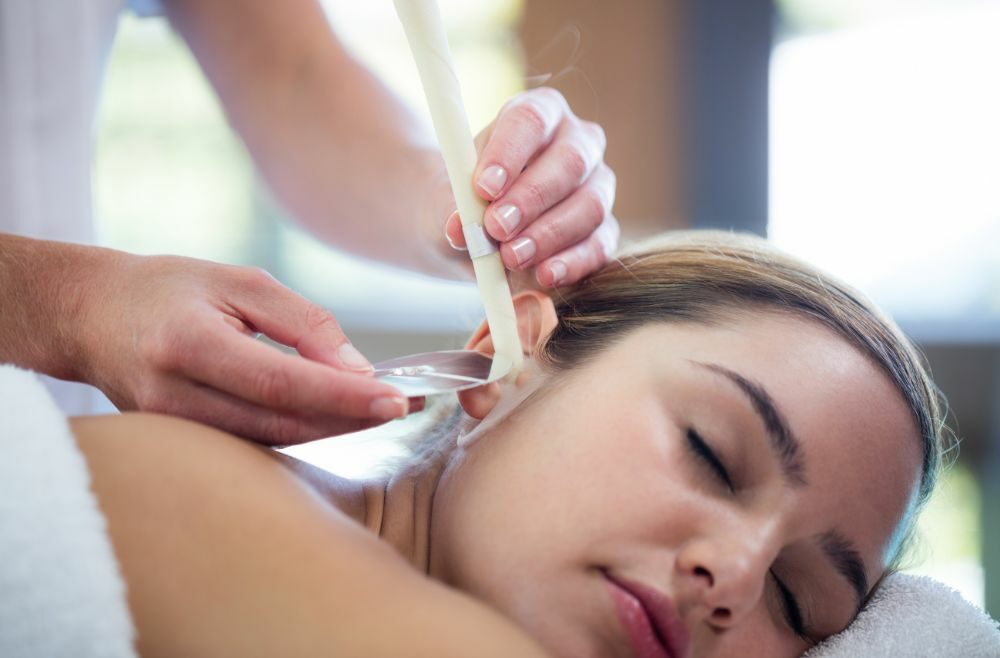Is ear candling effective? Or is it dangerous? If you do practice it, how often should you do ear candling?
In this article, we explore this topic and answer your most common questions.
This post contains some affiliate links to products that I use and love. If you click through and make a purchase, I’ll earn a commission, at no additional cost to you. Read my full disclosure here.
Your ears can experience many kinds of problems, such as infections or allergies. Ear candling can help you detect these problems and cure them. What you need to do is wait until youraurologist recommends doing ear candling for one of your conditions.
You can wax your ears at home using wax softeners and Q-tips to remove the excess earwax. Be careful with Q-tips. Many medical professionals suggest avoiding them because they can push wax deeper into the canel or damage the ear drum. The rule of thumb is anything smaller than your pinky finger should not go inside of your ear. Q-tips are for the outer ear, not the canel.
Make sure that you clean your ears carefully to avoid pushing the earwax deeper in your ear. Wax softeners can be purchased at any drug stores. HollowCare Therapeutics offers Ear Candling, which is a natural and safe way to clean out your ears and relieve pain associated with ringing in the ears (tinnitus), clogged ears, swimmer’s ear and more. (Check Price on Amazon)
What is Ear Candling?
The practice of ear candling has been around for centuries. It is a safe, natural, gentle method of cleansing and rejuvenating the ears, nose, throat, and head.
It is an ancient healing technique and is used mainly to remove impurities from the ear, nose and throat. The practice of ear candling has been dated back to early Christian times, and is believed to have originated in Eastern Europe.
Ear candling is relatively safe and has minimal side effects, including minor burns on the ear. To avoid the possibility of burns, a beeswax candle is used instead of a cotton one.
It can also benefit people who have sinus infections and those who are dealing with colds and congestion in the ears and/or the head. It is advisable for pregnant and lactating women to consult with their doctor before undergoing the procedure.
Ear candling can be used periodically as a preventative measure or for therapeutic reasons.
How To Do Ear Candling
With ear candling, a hollow cone of dried, rolled beeswax is inserted into the ear canal and lit with a hollow candle. The cone creates a vacuum, which causes the wax to slowly rise out of the ear through the cone and collect in a cup below it.
The candle flame acts as a catalyst, lowering the temperature of the ear wax, allowing for easier removal.
A Proper Ear Candling Session
1. Prepare the clean ear candle by making a wick using a cotton thread.
2. Regularly trim the wick using a scissors. The wick should be no more than 1/4 inch long.
3. Ensure that the ear candle is free from dust and debris before use.
4. Hold the ear candle upright and with both hands slide the wick into the hollow opening on the candle’s end.
5. Holding onto the ear candle with one hand, pull the outer end of the wick through the opening of the ear candle.
6. Hold the ear candle at a 45-degree angle and center the cone in the ear canal.
7. Light the candle and wait until the flame dies down.
8. You may hear a low humming sound from the ear candle while the candle is burning. This is a normal effect and does not indicate anything is wrong with the candle or ear.
9. Remove the ear candle from the ear and place it in the empty, flameless candle cup or paper plate.
10. You may also use an oil candle instead of a hollow wax cone, but the oil in the candle could be burned into the ear, resulting in an unpleasant odor.
11. Use a clean towel to dry your ears after cleaning.
Benefits of Ear Candling
Ear candling can help with various health conditions such as ear infections, hearing loss, tinnitus, and more. It’s a centuries-old treatment that originated from the Hopi Native American tribe (and was once used to treat headaches and migraines).
Proponents claim the candle also removes excess heat from the body, thereby providing relief from stress and improving blood circulation in the body. This brings balance to the functions of the ear, face and head.
It helps remove excess stress from the body (e.g., by relieving tension from muscles), making it a good stress reliever.
Other advocates of this natural alternative claim It also reduces inflammation of the jaw and neck, and is believed to be an effective treatment for headaches, sinus pressure, and migraines. Using ear candling to treat ear infections can enhance the removal of bacteria from the ear and improve blood circulation.
Additionally, ear candling boosts the immune system by increasing the blood’s oxygen supply, which increases the body’s ability to fight off disease. Additionally, it increases the flow of lymph in the body, which plays an important role in cleansing the body, eliminating excess toxins.
Those who advocate ear candling say, overall, ear candling can help you stay healthy and increase your immunity.
Click Here To Watch A Ground Breaking Video On The Ulitmate Hearing SolutionCons of Ear Candling
There are passionate advocates on both side of the issue when it comes to ear candling.
Advocates swear it is effective. We’ve already mentioned the benefits, so let’s take a look at the negative aspects.
No study has ever supported any of the claims made about the benefits of ear candling, according to WebMD.
There are several serious potential risks associated with ear candling according to VeryWellHealth, including:
- Hot wax and flame burns (most common)
- Dripping wax obstructs or blocks the ear canal
- Eardrum perforated (torn)
- Loss of hearing
- Infection of the outer ear (otitis externa)
Using lit candles close to your face is not recommended by the Food and Drug Administration (FDA). Even when the candle is used according to the manufacturer’s instructions, ear candling poses a high risk of skin/hair burns and middle ear damage.
In one study, the pressure measurements of the ear canal showed no negative pressure from burning candles, despite claims that earwax is removed through negative pressure from burning candles.
Many doctors debunk the idea that it works. Dr.Clifford R. Olson (doctor of audiology) tested the method and does not recommend it. You can watch the video here.
Alternatives to Ear Candling
There are a couple of things you can do instead of using an ear candle.
1) Hydrogen Peroxide
Lay on your side and use a dropper to put 5 drops of hydrogen peroxide in your ear. Let it sit in your ear for about two minutes. The hydrogen peroxide softens the wax.
You can also shake your head back and forth to loosen the wax. Then tilt your head to one side and drain out the loosened wax into a cup. Repeat on the other side if needed.
Some people find it helpful to place a warm washcloth over the area to soften the wax before you drain it out.
Do not put hydrogen peroxide in the ear canal if your eardrum has been ruptured, if you have an ear infection, or if you have fluid draining from your ear. It may burn your ear drum, which is very painful.
2) Warm Water
When you take a shower, rub a cotton swab around the outside of your ear – the warm water will help loosen any debris.
Make sure you never insert a cotton swab into your ear canal – cotton swabs have been known to burst eardrums if inserted too forcefully.
3) Salt Water
This natural wax removal remedy only requires one teaspoon of salt per half cup of warm water.
Use a cotton swab to gently rub the solution around your ear, allowing water to drip inside your ear canal. After a minute, tilt your ear down so you can drain the solution.
References
https://www.health.harvard.edu/staying-healthy/what-to-do-for-earwax
https://csef.usc.edu/History/2014/Projects/34488.pdf
https://www.webmd.com/cold-and-flu/ear-infection/what-is-ear-candling#1


